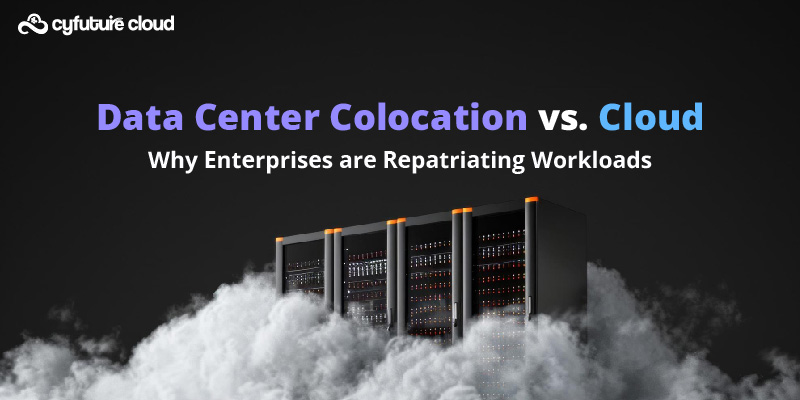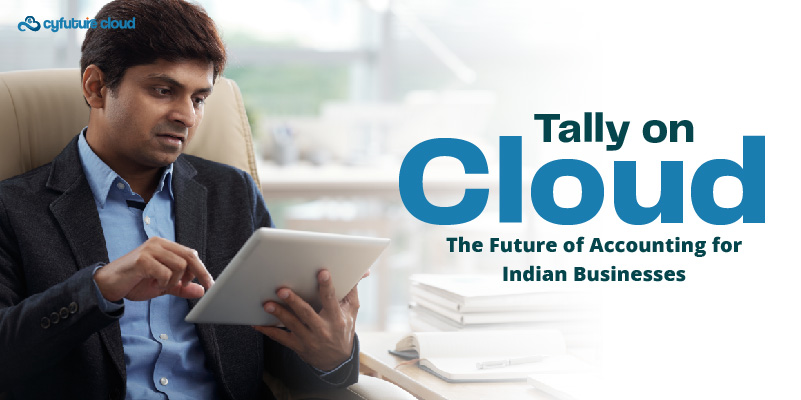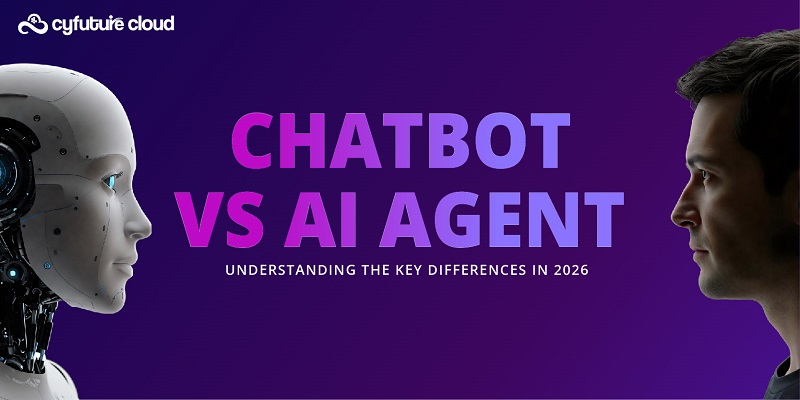Get 69% Off on Cloud Hosting : Claim Your Offer Now!
- Products
-
Compute
Compute
- Predefined TemplatesChoose from a library of predefined templates to deploy virtual machines!
- Custom TemplatesUse Cyfuture Cloud custom templates to create new VMs in a cloud computing environment
- Spot Machines/ Machines on Flex ModelAffordable compute instances suitable for batch jobs and fault-tolerant workloads.
- Shielded ComputingProtect enterprise workloads from threats like remote attacks, privilege escalation, and malicious insiders with Shielded Computing
- GPU CloudGet access to graphics processing units (GPUs) through a Cyfuture cloud infrastructure
- vAppsHost applications and services, or create a test or development environment with Cyfuture Cloud vApps, powered by VMware
- Serverless ComputingNo need to worry about provisioning or managing servers, switch to Serverless Computing with Cyfuture Cloud
- HPCHigh-Performance Computing
- BaremetalBare metal refers to a type of cloud computing service that provides access to dedicated physical servers, rather than virtualized servers.
-
Storage
Storage
- Standard StorageGet access to low-latency access to data and a high level of reliability with Cyfuture Cloud standard storage service
- Nearline StorageStore data at a lower cost without compromising on the level of availability with Nearline
- Coldline StorageStore infrequently used data at low cost with Cyfuture Cloud coldline storage
- Archival StorageStore data in a long-term, durable manner with Cyfuture Cloud archival storage service
-
Database
Database
- MS SQLStore and manage a wide range of applications with Cyfuture Cloud MS SQL
- MariaDBStore and manage data with the cloud with enhanced speed and reliability
- MongoDBNow, store and manage large amounts of data in the cloud with Cyfuture Cloud MongoDB
- Redis CacheStore and retrieve large amounts of data quickly with Cyfuture Cloud Redis Cache
-
Automation
Automation
-
Containers
Containers
- KubernetesNow deploy and manage your applications more efficiently and effectively with the Cyfuture Cloud Kubernetes service
- MicroservicesDesign a cloud application that is multilingual, easily scalable, easy to maintain and deploy, highly available, and minimizes failures using Cyfuture Cloud microservices
-
Operations
Operations
- Real-time Monitoring & Logging ServicesMonitor & track the performance of your applications with real-time monitoring & logging services offered by Cyfuture Cloud
- Infra-maintenance & OptimizationEnsure that your organization is functioning properly with Cyfuture Cloud
- Application Performance ServiceOptimize the performance of your applications over cloud with us
- Database Performance ServiceOptimize the performance of databases over the cloud with us
- Security Managed ServiceProtect your systems and data from security threats with us!
- Back-up As a ServiceStore and manage backups of data in the cloud with Cyfuture Cloud Backup as a Service
- Data Back-up & RestoreStore and manage backups of your data in the cloud with us
- Remote Back-upStore and manage backups in the cloud with remote backup service with Cyfuture Cloud
- Disaster RecoveryStore copies of your data and applications in the cloud and use them to recover in the event of a disaster with the disaster recovery service offered by us
-
Networking
Networking
- Load BalancerEnsure that applications deployed across cloud environments are available, secure, and responsive with an easy, modern approach to load balancing
- Virtual Data CenterNo need to build and maintain a physical data center. It’s time for the virtual data center
- Private LinkPrivate Link is a service offered by Cyfuture Cloud that enables businesses to securely connect their on-premises network to Cyfuture Cloud's network over a private network connection
- Private CircuitGain a high level of security and privacy with private circuits
- VPN GatewaySecurely connect your on-premises network to our network over the internet with VPN Gateway
- CDNGet high availability and performance by distributing the service spatially relative to end users with CDN
-
Media
-
Analytics
Analytics
-
Security
Security
-
Network Firewall
- DNATTranslate destination IP address when connecting from public IP address to a private IP address with DNAT
- SNATWith SNAT, allow traffic from a private network to go to the internet
- WAFProtect your applications from any malicious activity with Cyfuture Cloud WAF service
- DDoSSave your organization from DoSS attacks with Cyfuture Cloud
- IPS/ IDSMonitor and prevent your cloud-based network & infrastructure with IPS/ IDS service by Cyfuture Cloud
- Anti-Virus & Anti-MalwareProtect your cloud-based network & infrastructure with antivirus and antimalware services by Cyfuture Cloud
- Threat EmulationTest the effectiveness of cloud security system with Cyfuture Cloud threat emulation service
- SIEM & SOARMonitor and respond to security threats with SIEM & SOAR services offered by Cyfuture Cloud
- Multi-Factor AuthenticationNow provide an additional layer of security to prevent unauthorized users from accessing your cloud account, even when the password has been stolen!
- SSLSecure data transmission over web browsers with SSL service offered by Cyfuture Cloud
- Threat Detection/ Zero DayThreat detection and zero-day protection are security features that are offered by Cyfuture Cloud as a part of its security offerings
- Vulnerability AssesmentIdentify and analyze vulnerabilities and weaknesses with the Vulnerability Assessment service offered by Cyfuture Cloud
- Penetration TestingIdentify and analyze vulnerabilities and weaknesses with the Penetration Testing service offered by Cyfuture Cloud
- Cloud Key ManagementSecure storage, management, and use of cryptographic keys within a cloud environment with Cloud Key Management
- Cloud Security Posture Management serviceWith Cyfuture Cloud, you get continuous cloud security improvements and adaptations to reduce the chances of successful attacks
- Managed HSMProtect sensitive data and meet regulatory requirements for secure data storage and processing.
- Zero TrustEnsure complete security of network connections and devices over the cloud with Zero Trust Service
- IdentityManage and control access to their network resources and applications for your business with Identity service by Cyfuture Cloud
-
-
Compute
- Solutions
-
Solutions
Solutions
-
 Cloud
Hosting
Cloud
Hosting
-
 VPS
Hosting
VPS
Hosting
-
GPU Cloud
-
 Dedicated
Server
Dedicated
Server
-
 Server
Colocation
Server
Colocation
-
 Backup as a Service
Backup as a Service
-
 CDN
Network
CDN
Network
-
 Window
Cloud Hosting
Window
Cloud Hosting
-
 Linux
Cloud Hosting
Linux
Cloud Hosting
-
Managed Cloud Service
-
Storage as a Service
-
 VMware
Public Cloud
VMware
Public Cloud
-
 Multi-Cloud
Hosting
Multi-Cloud
Hosting
-
 Cloud
Server Hosting
Cloud
Server Hosting
-
 Bare
Metal Server
Bare
Metal Server
-
 Virtual
Machine
Virtual
Machine
-
 Magento
Hosting
Magento
Hosting
-
Remote Backup
-
 DevOps
DevOps
-
 Kubernetes
Kubernetes
-
 Cloud
Storage
Cloud
Storage
-
NVMe Hosting
-
 DR
as s Service
DR
as s Service
-
-
Solutions
- Marketplace
- Pricing
- Resources
- Resources
-
By Product
Use Cases
-
By Industry
- Company
-
Company
Company
-
Company
What Is Cloud Cost Optimization? Strategy & Best Practices for 2025
Table of Contents
Imagine this: Your enterprise’s innovation engine is running full tilt, spinning up VMs and microservices on demand. Budgets have been promised for digital transformation, but when the cloud bill lands at the end of the month, it’s enough to make even the bravest CTO pause. If this scenario strikes a chord, you’re not alone.
In 2025, cloud spend is expected to surpass $720 billion, with up to 32% of that spend wasted due to idle, overprovisioned, or underutilized resources. As enterprises accelerate adoption of cloud, artificial intelligence, and multi-cloud strategies, cloud cost optimization (CCO) has become a C-suite imperative—not just a finance function.
Defining Cloud Cost Optimization
Cloud Cost Optimization is the strategic and ongoing process of maximizing business value from cloud investments by minimizing waste, aligning resource allocation to actual demand, and reducing unnecessary spend—without sacrificing performance, security, or reliability.
The goal is not to cut costs recklessly, but to ensure every dollar spent on cloud resources drives measurable value for the business. Key components include monitoring, analytics, automation, governance, and cross-team collaboration (a core tenet of the emerging FinOps discipline).
Why Cloud Cost Optimization Matters—2025 Landscape
- Global cloud spend: Projected to reach $723.4 billion in 2025, representing 21.5% year-over-year growth.
- Budget waste: 32% of cloud budgets are wasted on unused, idle, or overprovisioned resources. Leading causes: idle/underused resources (66% of wasted spend), overprovisioning (59%).
- Cost escalation: 94% of IT leaders report rising storage and cloud costs; 59% say this significantly impacts bills.
- Enterprise priority: 67% of CIOs list cloud cost optimization as a top IT priority.
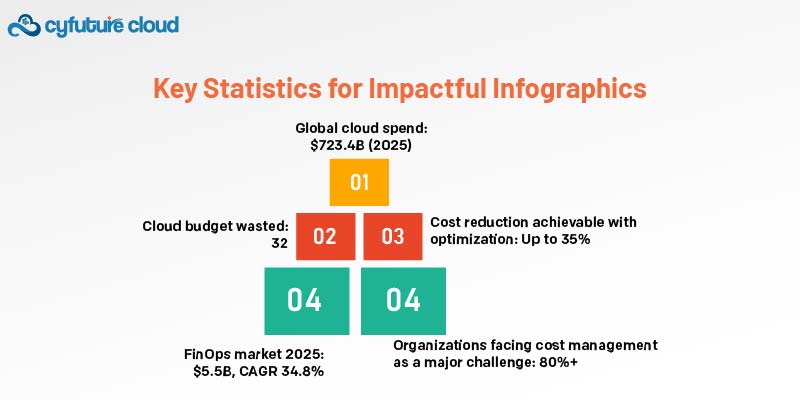
Key Statistics for Impactful Infographics
- Global cloud spend: $723.4B (2025)
- Cloud budget wasted: 32
- Cost reduction achievable with optimization: Up to 35%
- FinOps market 2025: $5.5B, CAGR 34.8%
- Organizations facing cost management as a major challenge: 80%+
Challenges in Optimizing Cloud Spend
- Multi-cloud complexity: With 78% of enterprises adopting hybrid cloud or multi-cloud, managing varied pricing models and data transfer charges is daunting.
- Lack of visibility: 20% of organizations admit little understanding of cost attribution.
- Operational complexity: 73% say cloud has increased operational complexity.
- GenAI workloads: Generative AI models introduce unpredictable burst spending, demanding even tighter cost controls.
Cloud Cost Optimization Strategies
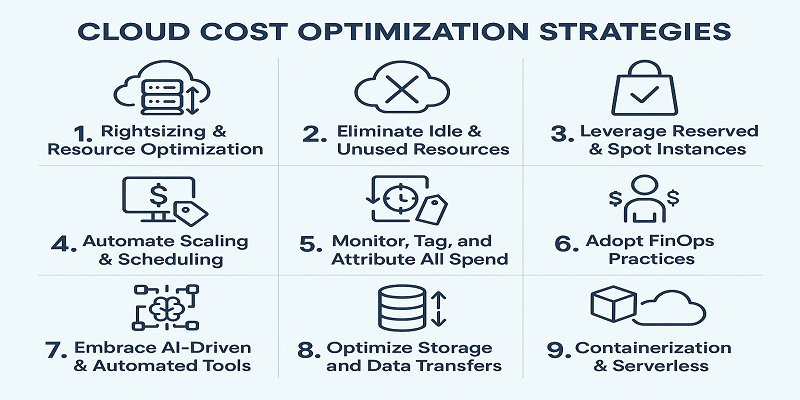
Here are the proven pillars of cloud cost optimization for technical leaders driving transformation:
Rightsizing & Resource Optimization
- Continuously analyze resource utilization (CPU, memory, storage) and adapt instance types, sizes, and allocations.
- Rightsizing, including automation tools, can yield 20–35% cost reductions.
Eliminate Idle & Unused Resources
- Automated identification and clean-up of idle VMs, unattached storage, or dormant network assets—60% of firms still report idle resources.
Leverage Reserved & Spot Instances
- Convert predictable workloads to reserved instances or savings plans for discounts up to 72%; use spot/preemptible resources for non-critical tasks.
Automate Scaling & Scheduling
- Implement auto-scaling, scheduled shutdowns, and workload placement to align resources with actual demand—cutting waste during off-peak periods.
Monitor, Tag, and Attribute All Spend
- Enforce organization-wide tagging for traceability and allocate spend by project, team, or business unit.
Adopt FinOps Practices
- Drive a cultural shift: finance, engineering, and product teams collaborate for shared accountability on cloud spend governance.
Embrace AI-Driven & Automated Tools
- Real-time, AI-powered cost management tools deliver predictive analytics and automated optimization, reducing bill spikes by 20% and enabling continuous savings.
Optimize Storage and Data Transfers
- Archive cold data, use cloud object storage tiers, and confidently manage data transfers to eliminate redundant copies and unnecessary ingress/egress fees.
Containerization & Serverless
- Moving workloads to containers or serverless architectures can cut infrastructure costs by up to 35%.
Future-Ready Cloud Optimization: The CXOs Imperative
Cloud cost optimization is no longer purely an IT or finance concern. In 2025, it sits at the core of digital transformation, sustainability, and product innovation. Tight cost controls, paired with powerful analytics and cross-functional collaboration, empower enterprises to fund innovation while protecting margins—a true win-win.
By embracing these strategies and best practices, CXOs can transform cloud cost optimization from a reactive function into a strategic lever for growth and resilience.
With cloud investments shaping the future of business, cost optimization is more than a strategy—it’s a competitive necessity.
Recent Post

Stay Ahead of the Curve.
Join the Cloud Movement, today!
© Cyfuture, All rights reserved.
Send this to a friend

 Pricing
Calculator
Pricing
Calculator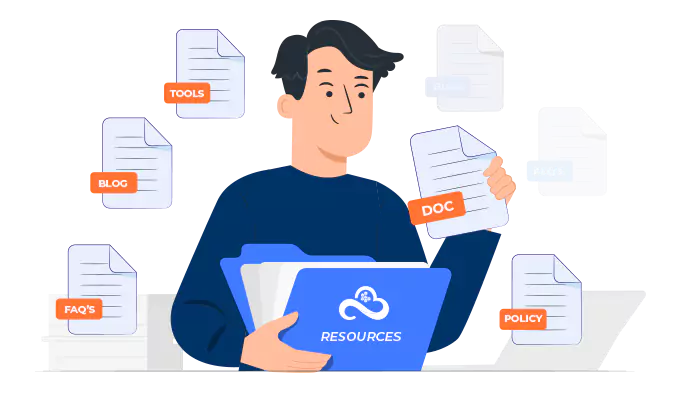
 Power
Power
 Utilities
Utilities VMware
Private Cloud
VMware
Private Cloud VMware
on AWS
VMware
on AWS VMware
on Azure
VMware
on Azure Service
Level Agreement
Service
Level Agreement 






